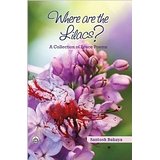Where are the Lilacs? Santosh Bakaya
When one begins to read the first section of Santosh Bakaya’s poetic offering ‘Where are the Lilacs?’ one can be pardoned if one thinks that this is a litany of peace poems, poems that could have been showcased in the Romantic era of Wordsworth, Keats and Shelley. Nature is seen at her beautiful best, as she conspires to sing songs of peace in her myriad forms. The joy of the rain, “the delectable petrichor”, adds a new essence even as the moon hums a peace song. Various species of birds – sparrows, goldfinches, love birds, canaries and doves continue “their litany of freedom” as dolphins cavort with the mermaids. The poet calls the moon her friend, guide and philosopher as she “hugged the moonbeams as they beamed/in my tiny heart”. The chubby five-year old savours the thrill of a rain holiday even as a desolate farmer grieves at his savaged fields.
The Lidder is a motif that stirs dreams within the heart of the poet, as it tickles her feet. The motif meanders on to a young girl who gazes at the river’s immensity with her blue eyes. There is intense joy in this set of poems as playful verbs dance across the pages... sparrows hop, a young lad dances in the rain, laughing doves chortle, squirrels slither and “a girl in a boat/...catches the raindrops on her face/And laughs and laughs”. The strains of peace sound in many of the poems, as even the trees sway and sing of peace.
However, there are moments when one is reminded of Tennyson’s “Nature, red in tooth and claw” when a happy child sleeps eternally after an explosion as “the lullaby freezes on petrified lips” or a vicious gale shatters the peace somewhere.
One of the most poignant poems sings of ‘The Petite Flautist’ “unleashing melodies of magic by his flute/In his dreary corner”.
In Part 11, the mood turns a trifle militant as young and old march on, “fleeing war and poverty” as “the bombers bombed/ And dreams were entombed”. Here, the references are connected to the real world, with references to little Aylan who drowned on the beach (“the child’s heart-rending screams”), the courage of Rosa Sparks (“a woman of spark”), a dirge to Gowhar who fell victim to a tear gas shell in Kashmir, and a paean to David Martello who soared his performance of Lennon’s ‘Imagine’ against the backdrop of the Paris violence.
Santosh Bakaya reveals a tender heart that weeps at a grave new world that is cacophonous, filled with resentment and riddled with corroded idealism. One discerns shades of Maya Angelou as she sings, “Let the bird in the cage serenade us with its notes of peace.” She goes on to beseech it to stay safe in its cage for “outside insane humanity is on the rampage”.
There are also cadences of Matthew Arnold’s “darkling plain” and Wordsworth’s “Bliss was it in the dawn to be alive”. Each of these strengthens the robust ideas that tumble out of the sparkling mind of the poet, as she continues to plead for peace. “Why should our battle cry be Hate? /Let the songs of/Peace/Resound and echo in the valley and dale,” and “My pen grows wings and sails with the feathered friends/Trying to forget a world gone berserk by its violent trends.”
This volume, replete with poems so relevant to the world today, and always, ends on a note of hope.
“Let us be together, little dove
All that the world needs is you
And a handful of love.”





This review made me cry .It is such a beautiful review . Thanks so much. I am tongue tied at the moment . Thanks and thanks and forever thanks...
ReplyDeleteThis review made me cry .It is such a beautiful review . Thanks so much. I am tongue tied at the moment . Thanks and thanks and forever thanks...
ReplyDelete